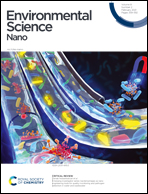Fluorescent plastic nanoparticles to track their interaction and fate in physiological environments†
Abstract
As the prevalence of plastic micro- and nanoparticles in the environment, foods, and beverages continues to increase, the risk of human exposure to and uptake of such particles, notably via ingestion or inhalation, is also elevated. Despite this development, relatively little is known about the potential adverse effects of plastic particles on humans. The lack of relevant plastic nanoparticles for use in studies investigating their behavior and effect on human cells is a key hurdle that must be overcome prior to generating hazard data. We herein demonstrate the creation of fluorescent nanoparticles of the thermoplastic polymers poly(ethylene terephthalate), polypropylene, and polystyrene. The particles were produced by melt-processing and milling. The analysis of scanning electron microscopy images showed core diameters of less than 75 nm. Furthermore, the images revealed that the milled particles had highly heterogeneous shapes, as is often seen in environmental samples. The particles were exposed to relevant cell lines (i.e. Caco-2 intestinal epithelial cells and J774A.1 macrophages) to determine their uptake, assessed by confocal laser microscopy, and biocompatibility, assessed by measuring the release of lactate dehydrogenase. Exposure data showed no cytotoxicity at the concentrations utilized in this study. Interaction of the particles was found to be cell type dependent, with agglomeration on the apical surface and few intracellular particles in the intestinal epithelial cells in comparison to numerous internalized particles in the macrophages. In conclusion, the herein presented melt-processing and milling methods resulted in heterogeneously shaped plastic nanoparticles with a fluorescence label allowing their behavior within a complex biological environment to be studied.



 Please wait while we load your content...
Please wait while we load your content...